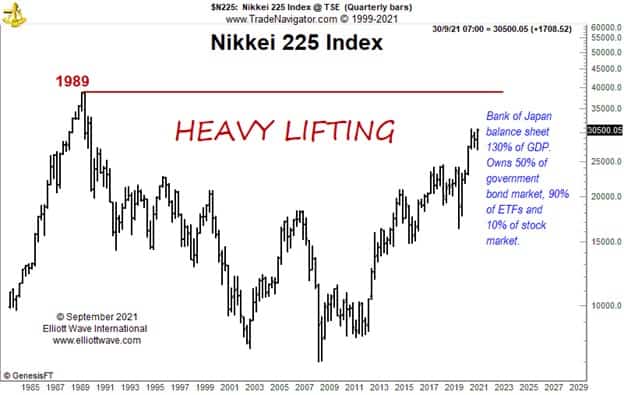A Deflation Mindset
When social mood turns negative, be prepared to be in for the long haul.
In 1980, a huge international hit song came from English band, The Vapors. “Turning Japanese,” is one of those songs that when it gets in your head you can’t get it out (as you, dear reader, will now find). In 1980, of course, Japan was lauded as being an economic miracle as its gross domestic product was surging and the country boomed. That lasted all through the 1980s until the bubble inevitably burst with the stock market topping out on the very last day of 1989. Ironically, since then, “Turning Japanese” has since come to be associated with a chronic economic slump and deflation.
The Governor of the Bank of Japan (BoJ), Haruhiko Kuroda, recently gave an interview in which he stated that, “past deflation is still affecting people’s mindsets.” It is refreshing to hear a central banker refer to mindset (or mood) as being the main cause behind economic developments, but the fact remains that Kuroda (as well as other central bankers) still thinks that mood can be changed through monetary policy. The evidence, however, does not support this.
Before getting into that, though, it must be said that the Bank of Japan and other central banks hamper themselves by focusing on the annualized rise in consumer prices as a metric; what they and everyone else call inflation. It is not. It is the change in consumer prices. Inflation is the expansion of money and credit, which may or may not have an effect on consumer prices. Nevertheless, the obsession with consumer price “inflation” has resulted in the Bank of Japan going completely bonkers in its attempt to achieve a 2% per annum target. The official short-term interest rate has been at essentially 0% or negative for the last two decades and, since 2013, the Bank of Japan’s Quantitative Easing policy (printing yen to buy assets such as bonds and stocks) has gone ballistic. The Bank of Japan’s balance sheet (a sign of how much money printing has been done) stands at an utterly incredible 130% of gross domestic product (GDP). Compare that with the Fed (30%) and the ECB (60%). With this money printing, the BoJ has indeed created surging inflation. Yet, because consumer prices are not rising by 2% per annum, it thinks that it needs to keep going.
The real reason behind the stagnation of consumer prices in Japan has been the fact that nominal wages have actually declined in Japan over the past two decades. That speaks to the deflation mindset which Kuroda is aware of. Central banks can print all the money they want to (inflation), but if wages aren’t rising it is difficult for consumer prices to accelerate. Western central banks should keep that in mind.

